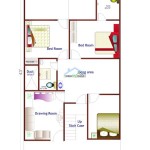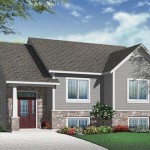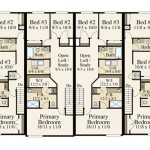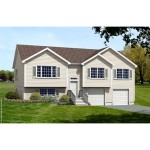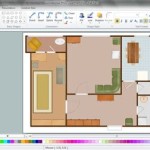House Plans with Open Floor Layouts: A Comprehensive Guide
Open floor plans have become a dominant trend in modern home design, fundamentally altering the way individuals and families interact within their living spaces. This design philosophy emphasizes spaciousness, connectivity, and natural light, creating an environment conducive to both social interaction and comfortable living. The popularity of open floor plans stems from their ability to adapt to diverse lifestyles and their potential to enhance the overall functionality and aesthetic appeal of a home.
Traditional house plans often feature distinct, enclosed rooms, each serving a specific purpose. This separation can sometimes feel isolating and hinder the flow of communication between occupants. In stark contrast, open floor plans typically eliminate or minimize walls between the main living areas, such as the kitchen, dining room, and living room, creating a large, unified space. This design promotes a sense of openness and allows for greater flexibility in how the space is utilized.
The shift towards open floor plans reflects a change in how people use their homes. With more emphasis on informal gatherings, family-centered activities, and multi-functional spaces, the open layout provides the ideal backdrop for modern living. It allows for seamless transitions between activities, making it easier to entertain guests while preparing food, supervise children while working, or simply relax in a comfortable and inviting environment.
However, despite the numerous advantages of open floor plans, it is essential to consider potential drawbacks and carefully plan the design to ensure functionality and comfort. Factors such as noise control, privacy, and spatial organization must be addressed effectively to create a truly successful and livable open space. Selecting the right house plan is crucial for maximizing the benefits of this design approach.
Key Advantages of Open Floor Plans
Open floor plans offer a multitude of benefits that contribute to a more enjoyable and functional living experience. These advantages extend beyond mere aesthetics, impacting the daily lives of the home's occupants in profound ways.
One of the primary benefits is the enhanced sense of spaciousness. By removing walls and creating a large, contiguous area, the open floor plan makes a home feel significantly larger than it actually is. This is particularly beneficial in smaller homes, where maximizing usable space is a priority. The absence of visual barriers allows natural light to penetrate deeper into the home, further contributing to the feeling of openness and airiness.
Another significant advantage is the improved flow of traffic. The open layout eliminates bottlenecks and promotes a smoother transition between different areas of the house. This is especially important for families with children or for those who frequently entertain guests. The unobstructed pathways allow for easy movement and interaction, creating a more social and engaging environment.
Furthermore, open floor plans facilitate better communication and interaction among family members. The absence of walls allows for easy conversation and visual connection, even when individuals are engaged in different activities. This can be particularly beneficial for parents who want to keep an eye on their children while preparing meals or for those who enjoy socializing while cooking. The open layout fosters a sense of togetherness and strengthens family bonds.
Finally, open floor plans offer greater flexibility in terms of furniture arrangement and space utilization. The absence of fixed walls allows homeowners to rearrange furniture and reconfigure the space to suit their changing needs and preferences. This adaptability is particularly valuable for those who enjoy entertaining, working from home, or engaging in hobbies that require a large, open area. The open layout provides a blank canvas for creating a personalized and functional living space.
Addressing Potential Challenges in Open Floor Plans
While open floor plans offer numerous advantages, it is important to acknowledge and address potential challenges that may arise. Careful planning and thoughtful design are essential to mitigate these issues and create a comfortable and functional living space.
One of the primary challenges is noise control. The absence of walls can lead to increased noise transmission between different areas of the house. Sounds from the kitchen can easily travel to the living room, potentially disrupting conversations or relaxation. To address this issue, consider incorporating sound-absorbing materials such as rugs, upholstered furniture, and acoustic panels. Strategic placement of these materials can help dampen sound and create a more peaceful environment. Additionally, appliances with low noise levels should be selected for the kitchen.
Another concern is the lack of privacy. The open layout can make it difficult to find a quiet and secluded space for relaxation or focused work. To address this, consider incorporating strategically placed dividers, such as bookshelves, screens, or partial walls. These dividers can create smaller, more intimate zones within the larger open space. Alternatively, designated quiet areas, such as a home office or reading nook, can be created in separate rooms or areas of the house.
Maintaining a sense of order and organization can also be challenging in an open floor plan. The absence of walls can make it difficult to define distinct spaces and prevent clutter from accumulating. To address this, consider incorporating ample storage solutions, such as built-in cabinets, shelving units, and concealed storage compartments. These storage solutions can help keep belongings organized and out of sight, maintaining a clean and uncluttered living space. Defining distinct zones within the open space through the use of rugs, furniture arrangements, and lighting can also help create a sense of order and visual separation.
Finally, managing temperature variations can be a challenge in an open floor plan. The large, open space can be difficult to heat or cool evenly, leading to uncomfortable temperature fluctuations in different areas of the house. To address this, consider investing in a high-efficiency HVAC system with zoned heating and cooling capabilities. This will allow you to control the temperature in different areas of the house independently, ensuring optimal comfort throughout the year. Additionally, proper insulation and energy-efficient windows can help minimize heat loss or gain, reducing energy consumption and improving overall comfort.
Essential Considerations for Selecting an Open Floor Plan House Plan
Choosing the right open floor plan house plan requires careful consideration of several factors to ensure that the design meets your specific needs and lifestyle. A thorough assessment of your preferences, priorities, and the characteristics of the building site is crucial for making an informed decision.
First and foremost, consider your lifestyle and how you intend to use the space. Think about your daily routines, hobbies, and entertaining habits. Do you frequently host large gatherings? Do you need a dedicated workspace? Do you prioritize privacy or prefer an open and social environment? Understanding your lifestyle will help you determine the optimal layout and features for your open floor plan.
Next, evaluate the size and shape of the building site. The dimensions and orientation of the site will influence the layout of the house and the placement of windows and doors. Consider the amount of natural light available and the prevailing wind direction. These factors will impact the energy efficiency and comfort of the home. A professional architect or designer can help you assess the site and develop a plan that maximizes its potential.
Furthermore, consider your budget and the cost of construction. Open floor plans often require larger spans and more complex structural elements, which can increase construction costs. Be realistic about your budget and prioritize features that are most important to you. Work with a reputable builder who has experience constructing open floor plans and can provide accurate cost estimates.
Finally, review the floor plan carefully and visualize how you will use the space. Pay attention to the placement of furniture, appliances, and fixtures. Consider the flow of traffic and the relationship between different areas of the house. Ensure that the plan meets your needs for storage, privacy, and functionality. Don't hesitate to make modifications to the plan to better suit your preferences and lifestyle. A well-designed open floor plan should be both aesthetically pleasing and functionally efficient, creating a comfortable and enjoyable living space for years to come.

Free Editable Open Floor Plans Edrawmax

Classic House Plans Open Concept Floor

Free Editable Open Floor Plans Edrawmax

Open Floor Plans Build A Home With Smart Layout Blog Dreamhomesource Com

10 Small House Plans With Open Floor Blog Homeplans Com

Open Floor Plans Creating A Breathable Livable Custom Home Builders Schumacher Homes

Open Concept Ranch Floor Plans Houseplans Blog Com

9 Best Open Floor Plans For Ranch Style Homes Deepnot Log Home House

House Design Trends What S Popular In Cur Floor Plans Extra Space Storage

Open Floor Plans Build A Home With Smart Layout Blog Dreamhomesource Com

